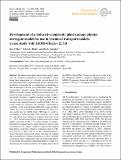Development of a reduced-complexity plant canopy physics surrogate model for use in chemical transport models: a case study with GEOS-Chem v12.3.0
Author(s)
Silva, Sam J; Heald, Colette L; Guenther, Alex B
DownloadPublished version (4.529Mb)
Publisher with Creative Commons License
Publisher with Creative Commons License
Creative Commons Attribution
Terms of use
Metadata
Show full item recordAbstract
© 2020 Copernicus GmbH. All rights reserved. Biosphere-atmosphere interactions strongly influence the chemical composition of the atmosphere. Simulating these interactions at a detailed process-based level has traditionally been computationally intensive and resource prohibitive, commonly due to complexities in calculating radiation and light at the leaf level within plant canopies. Here we describe a surrogate canopy physics model based on the MEGAN3 detailed canopy model parameterized using a statistical learning technique. This surrogate canopy model is specifically designed to rapidly calculate leaf-level temperature and photosynthetically active radiative (PAR) for use in large-scale chemical transport models (CTMs). Our surrogate model can reproduce the dominant spatiotemporal variability of the more detailed MEGAN3 canopy model to within 10 % across the globe. Implementation of this surrogate model into the GEOS-Chem CTM leads to small local changes in ozone dry deposition velocities of less than 5 % and larger local changes in isoprene emissions of up to <span classCombining double low line"inline-formula">ĝˆ1/440</span> %, though annual global isoprene emissions remain largely consistent (within 5 %). These changes to surface-atmosphere exchange lead to small changes in surface ozone concentrations of <span classCombining double low line"inline-formula">±1</span> ppbv, modestly reducing the northern hemispheric ozone bias, which is common to many CTMs, here from 8 to 7 ppbv. The use of this computationally efficient surrogate canopy model drives emissions of isoprene and concentrations of surface ozone closer to observationally constrained values. Additionally, this surrogate model allows for the further development and implementation of leaf-level emission factors in the calculation of biogenic emissions in the GEOS-Chem CTM. Though not the focus of this work, this ultimately enables a complete implementation of the MEGAN3 emissions framework within GEOS-Chem, which produces 570 Tg yr<span classCombining double low line"inline-formula">-1</span> of isoprene for 2012.
Date issued
2020-06Department
Massachusetts Institute of Technology. Department of Civil and Environmental EngineeringJournal
Geoscientific Model Development
Publisher
Copernicus GmbH
Citation
Silva, Sam J, Heald, Colette L and Guenther, Alex B. 2020. "Development of a reduced-complexity plant canopy physics surrogate model for use in chemical transport models: a case study with GEOS-Chem v12.3.0." Geoscientific Model Development, 13 (6).
Version: Final published version
ISSN
1991-959X
1991-9603